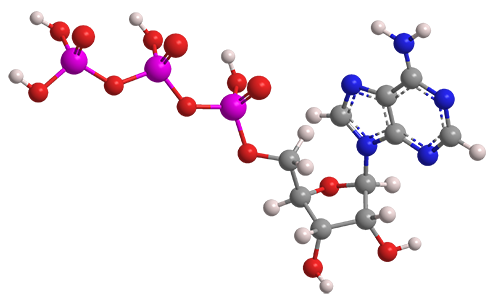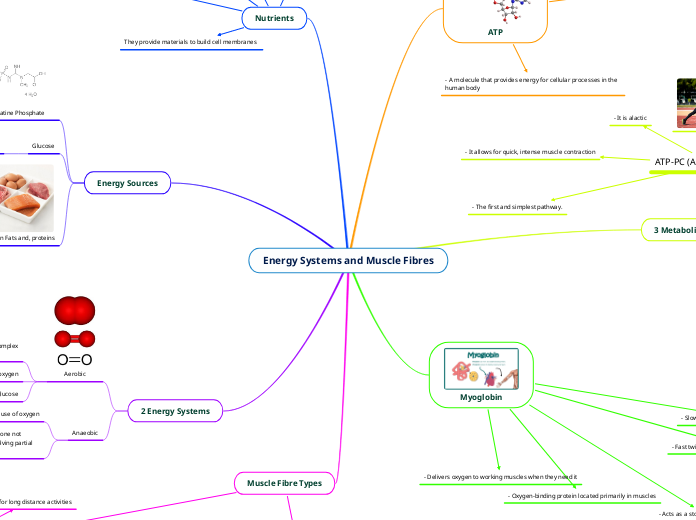Energy Systems and Muscle Fibres

ATP
- Break down of fuel molecules, proteins, fats, and carbohydrates
- A molecule that provides energy for cellular processes in the human body
_ There is 36 molecules of ATP, and there's three different processes that work to split ATP
3 Metabolic Pathways
ATP-PC (Anaerobic Alactic):
- Does not yield lactic acid as a by product
- The first and simplest pathway.
- It allows for quick, intense muscle contraction
- It is alactic
- Yields enough ATP for about 10-15 seconds of strenuous effort

Glycolysis (Anaerobic Lactic):
- 2 molecules of ATP for every molecule of glucose
- Involves the partial breakdown of glucose with lactic acid as a by product.
- Short bursts of energy for longer periods
- It does not involve oxygen and is anaerobic
- It allows longer bursts of energy
- Second energy pathway

Cellular Respiration:

Myoglobin
- Delivers oxygen to working muscles when they need it
- Oxygen-binding protein located primarily in muscles
- Slow twitch muscle fibres are high in myoglobin
- Fast twitch muscle fibres are low in myoglobin
- Acts as a storage unit for oxygen
Nutrients
Chemical substances obtained from food
Three key nutrients
Carbohydrates
Proteins

Fats
They supply energy, regulate cellular activity, and also build and repair tissue
One of the most important sources of
energy
They provide materials to build cell membranes
Energy Sources
Creatine Phosphate
The main high-energy, phosphate-storage molecule of muscle.
Glucose
A type of sugar you get from foods you eat, and your body uses it for energy.

Glycogen Fats and, proteins
Glycogen is the stored form of glucose that's made up of many connected glucose molecules.
Fats are nutrients in food that the body uses to build cell membranes.
Protein is a nutrient your body needs to grow and repair cells, and to work properly.
2 Energy Systems
Aerobic
- Involves many enzymes and several complex
sub-pathways
- Requires oxygen
- leads to the complete breakdown of glucose
Anaeobic
- Without the use of oxygen
- Can occur in two separate metabolic pathways, one not involving the breakdown of glucose, and one involving partial breakdown of glucose
Muscle Fibre Types
Slow Twitch Muscle Fibres:
Type 1 Fibres:
- Generate energy slowly
- Are more fatigue-resistant
- Primarily depend on aerobic processes
- These are dark or red in color
- Generate and relax tension relatively slow
- They are able to maintain a lower level of
tension for long durations.
- Ideal for long distance activities

Fast Twitch Muscle Fibres:
Type 2a Fibres:
- Muscle fibres are intermediate type muscle fibres
- They allow for high-speed energy release as well
as glycolytic capacity
Type 2b/x Fibres:
- Muscle fibres share lots of oxygen and sufficiently
high levels of enzymes necessary for quick contraction
requiring oxygen.
- More pale in color
- Have the ability to tense and relax quickly
- Can generate large amount of tension with
relatively low endurance levels
- Ideal for short lasting activities.
